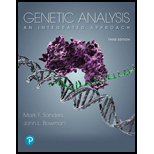
Concept explainers
What is CODIS? Describe the four most important feature of gentic markers used in the system.
To analyze:
Describe CODIS and the four most important characteristics of genetic markers used in this system.
Introduction:
In
Explanation of Solution
CODIS – The United States national DNA database is Combined DNA Index System. Federal Bureau of Investigation (FBI) formed it and preserved it. Depending on the type of information being searched against, the CODIS software contains multiple different databases. These databases include forensic samples collected from crime scenes, missing persons, etc.
The genetic markers used in forensic genetic analysis are short tandem repeats (STRs) which contain different numbers of copies of short, repeating sequences of DNA. STRs are less than ten base pairs long and follow a co-dominant pattern of inheritance.
There are four important features of genetic markers – STRs used in CODIS. These include –
A CODIS STR must have a known location of chromosome and the location should ensure that the STR follows independent assortment from all other CODIS markers. This is important for calculation of individual identity.
A CODIS STR must have multiple alleles in all examined populations. The allele should not a frequency more than twenty to twenty five percent in a population. This increases the effectiveness of individual genetic identification.
A CODIS STR must carry alleles that can be amplified by PCR consistently, reliably, and accurately. These alleles should be such that they can be analyzed in highly automated laboratory settings in specially equipped laboratories. This is required to minimize the risk of contamination of DNA samples and to ensure the reproducibility of the results.
The last criterion for CODIS STRs is that their PCR products must distinguish alleles from one another clearly enough for automated PCR amplification and gel electrophoresis. This is required for reliable identification of each allele.
CODIS is an important software, containing different types of databases which are used for the forensic investigation.
Want to see more full solutions like this?
Chapter E Solutions
Genetic Analysis: An Integrated Approach (3rd Edition)
- please draw in what the steps are given. Thank you!arrow_forwardplease draw in and fill out the empty slots from image below. thank you!arrow_forwardThere is a species of eagle, which lives in a tropical forest in Brazil. The alula pattern of its wings is determined by a single autosomal gene with four alleles that exhibit an unknown hierarchy of dominance. Genetic testing shows that individuals 1-1, 11-4, 11-7, III-1, and III-4 are each homozygous. How many possible genotypes among checkered eagles in the population?arrow_forward
- students in a science class investiged the conditions under which corn seeds would germinate most successfully. BAsed on the results which of these factors appears most important for successful corn seed germination.arrow_forwardI want to write the given physician orders in the kardex formarrow_forwardAmino Acid Coclow TABle 3' Gly Phe Leu (G) (F) (L) 3- Val (V) Arg (R) Ser (S) Ala (A) Lys (K) CAG G Glu Asp (E) (D) Ser (S) CCCAGUCAGUCAGUCAG 0204 C U A G C Asn (N) G 4 A AGU C GU (5) AC C UGA A G5 C CUGACUGACUGACUGAC Thr (T) Met (M) lle £€ (1) U 4 G Tyr Σε (Y) U Cys (C) C A G Trp (W) 3' U C A Leu בוט His Pro (P) ££ (H) Gin (Q) Arg 흐름 (R) (L) Start Stop 8. Transcription and Translation Practice: (Video 10-1 and 10-2) A. Below is the sense strand of a DNA gene. Using the sense strand, create the antisense DNA strand and label the 5' and 3' ends. B. Use the antisense strand that you create in part A as a template to create the mRNA transcript of the gene and label the 5' and 3' ends. C. Translate the mRNA you produced in part B into the polypeptide sequence making sure to follow all the rules of translation. 5'-AGCATGACTAATAGTTGTTGAGCTGTC-3' (sense strand) 4arrow_forward
 Human Heredity: Principles and Issues (MindTap Co...BiologyISBN:9781305251052Author:Michael CummingsPublisher:Cengage LearningCase Studies In Health Information ManagementBiologyISBN:9781337676908Author:SCHNERINGPublisher:Cengage
Human Heredity: Principles and Issues (MindTap Co...BiologyISBN:9781305251052Author:Michael CummingsPublisher:Cengage LearningCase Studies In Health Information ManagementBiologyISBN:9781337676908Author:SCHNERINGPublisher:Cengage Biology: The Dynamic Science (MindTap Course List)BiologyISBN:9781305389892Author:Peter J. Russell, Paul E. Hertz, Beverly McMillanPublisher:Cengage Learning
Biology: The Dynamic Science (MindTap Course List)BiologyISBN:9781305389892Author:Peter J. Russell, Paul E. Hertz, Beverly McMillanPublisher:Cengage Learning Concepts of BiologyBiologyISBN:9781938168116Author:Samantha Fowler, Rebecca Roush, James WisePublisher:OpenStax College
Concepts of BiologyBiologyISBN:9781938168116Author:Samantha Fowler, Rebecca Roush, James WisePublisher:OpenStax College Principles Of Radiographic Imaging: An Art And A ...Health & NutritionISBN:9781337711067Author:Richard R. Carlton, Arlene M. Adler, Vesna BalacPublisher:Cengage Learning
Principles Of Radiographic Imaging: An Art And A ...Health & NutritionISBN:9781337711067Author:Richard R. Carlton, Arlene M. Adler, Vesna BalacPublisher:Cengage Learning





